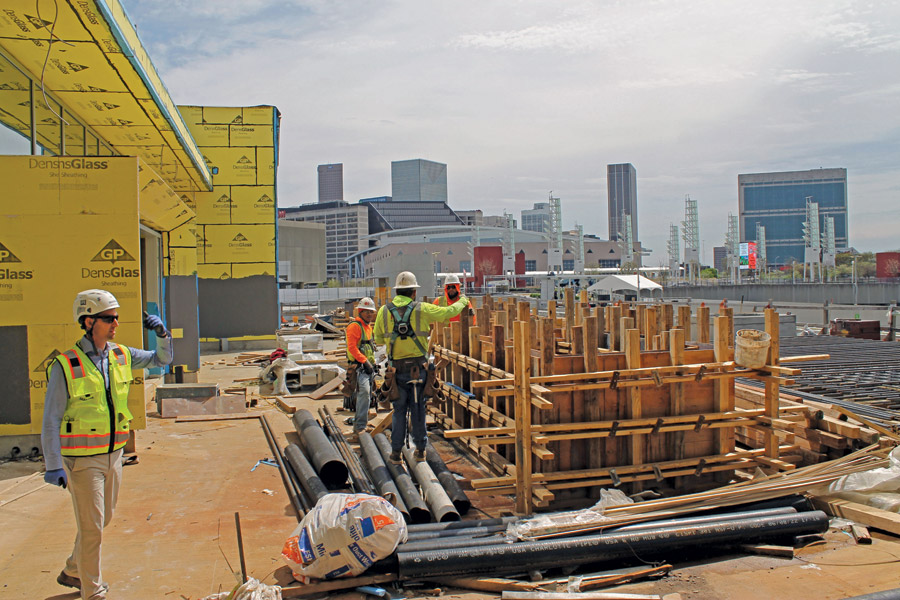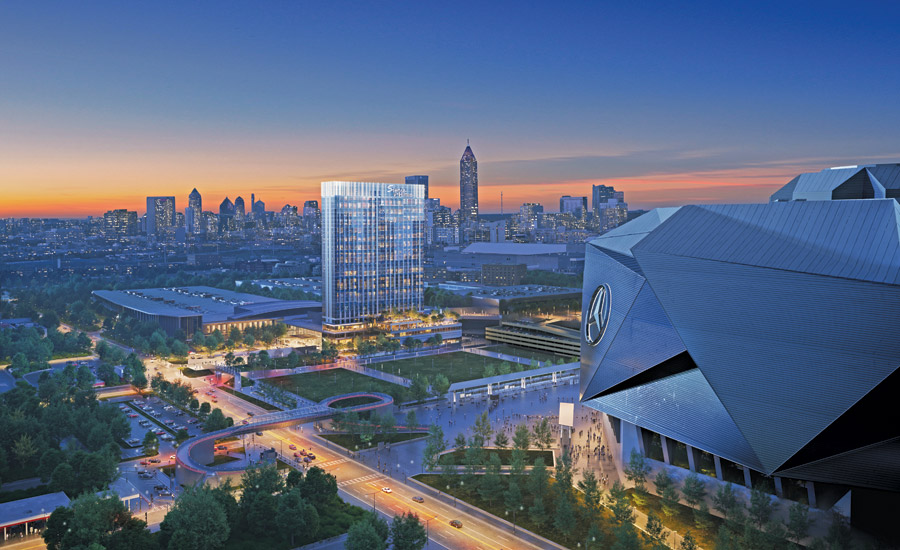When the Georgia World Congress Center Authority (GWCCA) started planning a hotel for its convention center in the heart of Atlanta, it seemed straightforward enough: Dedicate some space, including at the site of the former Georgia Dome, and get to work. But the years of planning, a global pandemic and building atop those existing foundations each left the project team with plenty of complicated puzzles to solve.

Built atop foundations of the demolished Georgia Dome and an existing parking deck, the 42-story hotel topped out March 28.
Photo by Derek Lacey for ENR
Committing to Hospitality
Planning for the hotel, set to become the first newly constructed property to carry the Signia name, dates to several feasibility studies in 2013, says Kevin Duvall, chief operating officer for GWCCA, the largest combined convention, sports and entertainment campus in North America. The Drew Co. development team, including Gensler as designer and Skanska as builder, was selected in October 2015, years before the COVID-19 pandemic would sweep across the planet, throwing the construction industry, and especially the hospitality industry, into uncertainty.
Taking a slight pause on its hotel plans, GWCCA continued to improve the drawings. Even as it wrestled through the pandemic, ran the numbers and felt confident in market demand for the hotel, Duvall says that in March 2021 the project became like a bellwether to see how the pandemic-stricken market would react to bond issuances for a roughly 1,000-room hotel.
“We felt the long-term viability was solid and [that]we would bounce back, and we have.”
— Kevin Duvall, COO, Georgia World Congress Center Authority
“We felt the long-term viability was solid and [that] we would bounce back, and we have,” Duvall says.
In April 2021, it became one of the first large hospitality projects to be released with funding to start construction following the pandemic, says Robert Fischel, hospitality leader at Gensler, adding that it shows a real commitment on the part of GWCCA.
“We got very fortunate with limited impacts from the pandemic,” Duvall says.
Ultimately, he notes that change orders constituted 6% of the original estimated cost of $308 million, bringing the current total project cost to $326 million.
Plans solidified for a headquarters hotel connected directly to the convention center: a 1.2-million-sq-ft, 976-room, 42-story tower. Construction started in May 2021. The project is diverting 85% of its waste from landfills and is seeking a LEED Gold rating. On March 28, the almost 453-ft-tall structure topped out on its way to a scheduled January 2024 opening.

The Signia by Hilton is close to major stadiums and attached to the Georgia World Congress Center, offering guests walking access to conventions, sports and entertainment.
Photo by Derek Lacey for ENR
Getting a Solid Footing
The construction team didn’t just have to wrestle with being connected to the GWCC and in close proximity to busy venues such as Mercedes-Benz Stadium, the home of the NFL’s Atlanta Falcons, and State Farm Arena, home of the NBA’s Atlanta Hawks, but it also had to deal with the structure being built on top of foundations from the former Georgia Dome stadium and a two-level parking deck.
“The way the hotel sits in there looks simple,” Fischel says. “It looks like it’s a very obvious solution. I can tell you it took us a long time.”
It took the team 12-18 months and lots of different studies of how to make it work, he says, as they contended with the multiple different elevations of the site. Andrew Young Boulevard, which provides pedestrian access to Mercedes-Benz Stadium and GWCC, is on the hotel’s fourth level, and North Side Drive, to the west of the hotel, provides the main entrance to the lobby at the hotel’s ground floor—a difference of approximately 45 ft between the two sides.
“Somebody staying at the hotel can use the building to connect at multiple levels in different directions between the different events going on, whether it’s staying for a football game, going to a stadium or going to a convention,” Fischel says. “It’s a very integrated building.”
That hurdle cleared, work on the ground began—and what ground it is. The hotel sits on top of three different ground conditions, giving the development team plenty of work to do before vertical construction started.
“It sounds pretty straightforward, finding that little corner between Buildings B and C where you’re going to nestle a hotel, but it gets a little more complicated when you think about it three dimensionally,” Fischel says. “And also the foundations.”

Alongside views of Mercedes-Benz stadium and a deck overlooking the Home Depot Backyard greenspace, a sports bar on the fourth level includes a wrap-around TV screen.
Rendering courtesy Gensler
The structure, consisting of a podium and tower with footprints of 100,000 sq ft and 18,500 sq ft, respectively, sits on an existing two-story parking deck, foundations from the demolished Georgia Dome and a small portion of undeveloped ground, Fischel explains, as well different mechanical and utility traces left below grade.
“There was lots of fun stuff to find below grade,” he says, which limited where deep foundations could be located to be most efficient and cost effective, and it came down to a simple solution: a podium with a tower element.
It required reinforcement of the columns and foundation, but with a combination of topping slabs and beams, the team was able to spread out the load to accommodate the podium’s weight and take the superstructure with its deep foundations straight to grade, either by adding additional pilings, expanding caps or putting in new deep foundations.
existing site conditions rank as the top challenge for the project, says Mark Pasciuto, project executive for Skansa, who adds that a retaining wall was first built to facilitate mass excavation before inspecting the existing conditions and eventually installing just under 300 auger-cast piles and 60 caissons with diameters between 54 in. and 86 in.
“Coming out of the ground was a challenge,” Pasciuto says, but the tem built in a time allowance in the contract with that in mind, and the project remains on time and on budget.
“That’s much more of a collaborative process than you often see in a typical design-bid-build.”
—Robert Fischel, Principal, Hospitality Lead, Gensler
There are 50,000 cu yd of concrete for the entire project, he says, about 45,000 of which have been placed as of the end of March, and 3,000 tons of structural steel. The podium is structural steel, and the tower is cast-in-place concrete.
The team was also able to learn from GWCCA’s construction of the orange deck adjacent to the hotel on top of the Georgia Dome, which is built on those existing foundations, too, Fischel says, allowing designers to map out what the apparent as-built conditions were. Walter P Moore and Skanska worked closely with Gensler to do a lot of that investigation and confirm those conditions, though the team still had to be flexible once work began, including as the convention center continued to operate. According to its website, Walter P Moore’s team specified and designed a proprietary braced frame system to lower the seismic load on the ballroom to mitigate structural strengthening of the parking deck below.

The 453-ft-tall tower makes the Signia by Hilton the tallest hotel to be constructed in Atlanta in 40 years.
Photo courtesy Skanska/SG Contracting
Coordinating Through Challenges
The impacts of the pandemic are still rippling across this project. One of those, Fischel says, is the frontloading of submittals.
As the team worked to lock in subcontractors and acquire things with expected long lead times such as elevators and mechanical equipment, other materials not normally ordered so far in advance started to be frontloaded, leaving folks like Fischel to review items like wall coverings and glue for carpet alongside foundation concrete.
“You don’t need it for two years, but we’re having to review it because they’re trying to lock in and literally purchase that scope of work,” he says.
Alongside the typical review of photographs and insurance certificates for stored materials, they were also reviewing generic things like stored drywall and paint that had to be vetted thoroughly to make sure it was the right product and was dedicated to the right project.
“Skanska might come to the table and say, ‘We just found X, Y, Z pricing is about to jump in 30 days, what can we do to nail down the quantity or profiles? Or what is the system going to be?’” he says. “We would have to quickly figure out how to work with them and get that locked down. And that’s much more of a collaborative process than you often see in a typical design-bid-build.”
“The intent was to have one wide open space, but constructing [the grand ballroom] was a challenge.”
—Mark Pasciuto, Project Executive, Skanska
It’s something Fischel says he’s never seen before and he hopes to never see again, but it meant the developer, contractor and design team all had to stay in close coordination throughout the project.
Pasciuto points to roofing as a particular example. In 2021, when Skanska began procuring subcontracts, it heard that coverboard was very difficult to get and lead times were running into 2023.
Skanska leveraged its national supply chain team, partnering up with the subcontractor and material manufacturer to find substitutions, coordinating with the owner and design team to get materials in August and help the project hit its milestones.
A tight site, not only downtown, but next door to major professional sports stadiums and an active convention center, presented challenges too.
“Generally speaking, the footprint is the construction site,” Pasciuto says.
Utilizing local subcontractors—about 90% of which have offices in Georgia—with Skanska’s own “robust offsite stored materials process” also helped address long lead times, inflation and cost escalations, Pasciuto says, though there is a bit of laydown room on the site being utilized by the structural concrete subcontractor to bring in and tie rebar.
Mangum Street, which accesses the convention center near the southeast corner of the hotel site, presented another coordination challenge, Pasciuto says, including GWCC’s loading dock.
“That obviously is a very tight logistical area,” he says, with sewer and stormwater utilities and deliveries from 53-ft tractor trailers that all had to be coordinated on a daily basis to allow utility work and deep excavations to happen.

The 40,000-sq-ft grand ballroom was constructed using long-span trusses and no columns.
Photo by Derek Lacey for ENR
Visit for a While
Already topped out, the tower is making its mark on the Atlanta skyline as the tallest hotel built in the city in four decades, according to Skanska, and is set to have a big impact on the people who walk through its doors as well.
One of the premier spots of the building is the cavernous grand ballroom, a 40,000-sq-ft room constructed without columns using long-span trusses measuring more than 200 ft, Pasciuto says.
“The intent is to have one wide open space, but constructing it was a challenge,” he says, explaining that the trusses had to go up in sequences, temporarily shored until the entire system was in place, and then the shoring was removed to reveal the open space with its coffered ceilings ready for chandeliers.
“One of the key takeaways of hospitality, especially today, is creating hospitality experiences that are very unique to the location,” Fischel says. “If I’m traveling to Atlanta, I want to get a sense of what is Atlanta?”
For this project, that means a distinctive Atlanta experience representing the best of Southern hospitality, he says, with an intentional arrival on the north side of the building with two-story glass straight to a porte cochere, somewhat representative of a front porch.
“So it’s ... come, sit, visit for a while,” Fischel says. “And that happens throughout several locations.”
In late March, crews were installing curtain wall in the main lobby, the ceiling of which includes 98 different hang points for a planned substantial work of art, Pasciuto says.
And with views of Mercedes-Benz Stadium directly to the south of the building, part of that identity is sports. A sports bar on the fourth level with wrap-around TV screens reflects that. There are also multiple outdoor areas that look down on the Home Depot Backyard, an 11-acre, multi-use greenspace adjacent to Mercedes-Benz Stadium.
All of that is supported by robust back-of-house facilities, including chillers and hot water boilers because the building is not served by any offsite campus, Pasciuto says.
Hilton has a reputation for large meeting and convention spaces, and the hotel now rising over Atlanta is the result of a lot of collaboration with Hilton on what a Signia by Hilton should represent, Fischel says, with the new building becoming the brand standard.
Pasciuto says it will be something to be proud of, “to walk away from a building, a significant one like this, and to understand what it took to build it and all the effort that people put into it and the challenges you had to overcome.”





